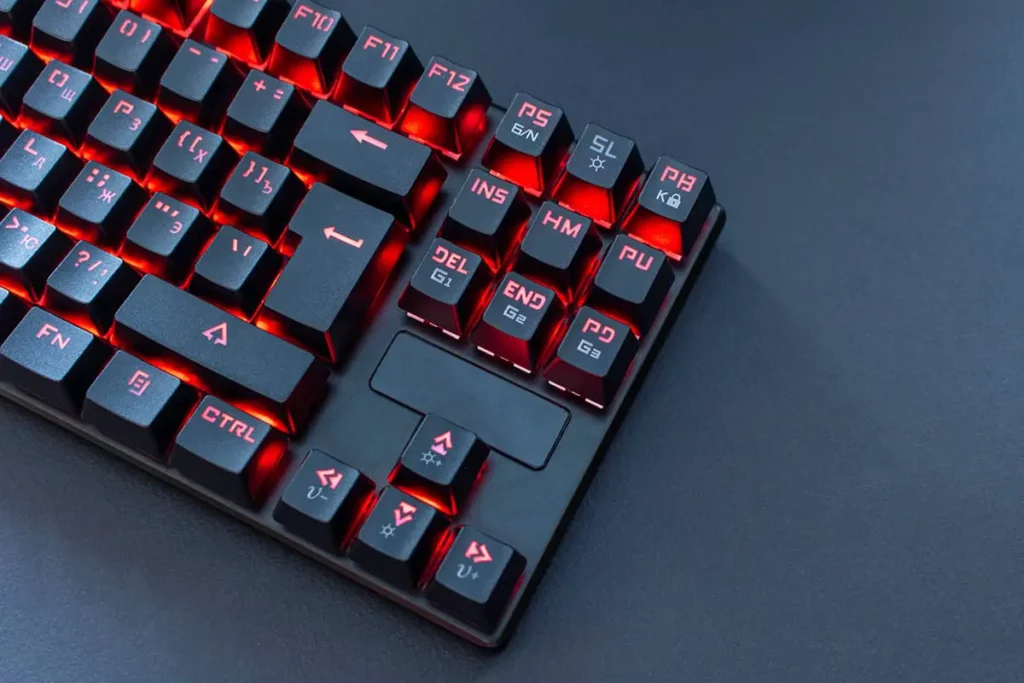Mechanical keyboards have been around since the 1980s. But recently, they’ve become more popular thanks to gaming enthusiasts. If you’ve ever wondered why mechanical keyboards click, then today is your lucky day! This post will explain what’s happening with each keystroke.
Mechanical keyboards click because a spring beneath the keycap is pushed down to connect with the underlying circuit when you press a key. You hear a clicking sound due to the friction produced by the spring colliding against the stem of the keycap.
There are a few different reasons why mechanical keyboards click, and we’ll go over them in detail below. If you’ve ever wondered about the phenomenon of clicking keyboards, or if you just want to know more about what makes these keyboards so unique, this article is for you.
How Mechanical Keyboards Work
A mechanical keyboard is a special type of keyboard that uses physical switches under each key to register keystrokes instead of using a single sheet membrane for the entire keyboard. They’re used in place of the rubber dome switches found on standard keyboards, which require activation before registering a keystroke.
Mechanical keyboards are preferred by some professionals over membrane keyboards because they feel more responsive and can last longer.
Mechanical keyboards are so named because the switches that are activated by each key are individually engineered with proper springs and metal contacts.
These springs provide a consistent movement, and the metal contacts are hard-wearing, making for a keyboard that lasts longer, provides a more reliable typing experience, and can improve typing speed. On the other hand, membrane keyboards tend to be unreliable, have a shorter lifespan, and feel more inconsistent.
Other Types of Keyboards
There are many different types of keyboards available to consumers today. Each keyboard has its own unique layout and feel, making it more or less ideal for specific users. The two most popular keyboard types are membrane and mechanical.
Membrane keyboards are thin and low profile; they’re preferred by people who like laptop-style typing on a desktop keyboard. Mechanical keyboards have much higher durability than membrane models, making them better suited for frequent typists.
Anatomy of a Mechanical Keyboard
The three most essential parts of a mechanical keyboard are:
- The Keycap: This is the plastic cap that is placed on top of the mechanism. It displays the character you’re about to press.
- The Stem: This is the component beneath the keycap. When you press a key, the stem is pushed down and connects to the circuitry underneath.
- The Housing: This is the physical case that binds all of the switch components together.
Mechanical keyboards are, in essence, a kind of ‘throwback’ to earlier keyboard designs. Rather than having rubber domes underneath the keys, which have their own individual switches connected to them, mechanical keyboards have key switches directly beneath the keycaps themselves. This means that there are fewer parts within the keyboard itself, thus reducing cost and improving reliability.
How the Mechanical Switch Works
Think of a mechanical switch as a typical switch found on wall panels. Turning the switch on will complete the circuit and turn on whatever appliance it’s connected to—in our case, this will register a keystroke. In the normal unpressed state, the switch is kept open by a prong attached to the slider, preventing contact between the stem and housing.
When a keycap is pressed, the slider moves down and forces the prongs out of the way. Once the stem makes contact with the housing, the keystroke is registered. When the user releases the keycap, the spring underneath the keycap forces the slider to rise. In doing so, the prong interacts with the switch and turns it off. Finally, the keycap returns back to its normal state and is ready to be pressed again.
This process holds true for the majority of mechanical keyboards available in the market today. Certain custom-made keyboards may have a different underlying mechanism, but such keyboards are rare and difficult to acquire.
Linear, Tactile, or Clicky
There are three main types of switches in mechanical keyboards – Linear, Tactile, and Clicky switches:
- Linear: Linear switches have to be pushed all the way down before a keystroke can be registered. These types of switches are ideal for gamers who are wary of their key presses.
- Tactile: Tactile switches can register a keystroke even when the key is pushed halfway down. This feature is great for developers and typists who want their keys to register rapidly without having to press all the way down.
- Clicky: Clicky switches work on the same principle as Tactile switches, but they also produce an audible sound when pressed, hence the name “clicky.”
Cherry Switches in Mechanical Keyboards
Back in the early 1980s, a company called Cherry introduced the first mechanical switches for keyboards known as Cherry MX switches. Today, many well-known brands are still using Cherry MX switches for their mechanical keyboards.
Cherry MX switches are the most popular mechanical keyboard switches in the world. They come in various types based on auditory, tactile, and actuation forces. The table below shows the most common Cherry MX switches:
| Type of Switch | Description | Actuation Force | Auditory Nature |
| Cherry MX Red | Completely linear up and down motion. Keys need to be pressed all the way down to register. Ideal for Gamers. | 45 G | Smooth keystrokes with minimal noise. |
| Cherry MX Black | A Stiffer version of Cherry MX Red. Ideal for RTS games where you don’t want to press the wrong key by accident. | 60 G | High precision keystrokes with minimal noise. |
| Cherry MX Blue | Tactile switch that works even when half-pressed. Ideal for typists and developers. Provides a clicking sound. | 50 G | Produces the most audible noise (feedback) out of all the Cherry MX switches. It can be too loud for an office environment. |
| Cherry MX Green | A stiffer version of the Cherry MX blue switch. These switches need considerable force to be pressed down. | 80 G | Same auditory nature as Cherry MX Blue. |
| Cherry MX Brown | Cherry MX Brown introduces tactile feedback by having a slight bump when pressed. An ideal choice for gamers and typists. | 45 G | Makes a clicky sound when the button is pressed, but not too intense like the Cherry MX blue. |
| Cherry MX Clear | Very high actuation force means that you have to exert additional pressure for a keystroke to be registered. Not recommended for typists. | 95 G | Same auditory nature as Cherry MX Brown. |
Key Features of a Good Mechanical Keyboard
There are five key features to look for in a mechanical keyboard to ensure you find one of good quality: switch type, noise, travel distance, keycaps, and the N-Key Rollover. Let’s look at each of these individually.
Switch Type
If you’re out to buy a mechanical keyboard, the first thing to consider is the type of switch you want underneath your keycaps. Switch type emphasizes the function you wish the mechanical keyboard to fulfill as well as your general experience and comfort.
It’s important to remember that each switch type is distinct in its own manner:
- Linear Switch: A linear switch is recommended for individuals who want a smooth typing experience but also want to ensure they don’t accidentally press a different key. The linear switch is typically preferred by professional gamers—you don’t want to mess up and press the wrong key during a professional esports match.
- Tactile Switch: Tactile switches are the most common switch type. With a tactile bump, you receive tangible feedback once a keycap is pressed. They also produce an audible sound which makes it easier to determine whether you’ve pressed the key or not. Tactile Switches are quieter than Clicky switches, making them an ideal choice for the office environment.
- Clicky Switch: Take a tactile switch and make it louder—viola, you have a Clicky switch. This switch type is great for individuals who are frequently typing, such as freelance writers or programmers.
Noise
Mechanical keyboards produce noise when the keys are pressed. The type of sound they make is dependent upon the switch type. This factor is one of the selling points for mechanical keyboards; most users find the sounds to be pleasing and gratifying.
Linear switches make the least noise and are virtually silent. Feedback is almost non-existent for these switches.
Tactile switches produce moderate noise when pressed. The feedback is enough to stimulate your senses but might be a tad underwhelming for some users.
Clicky switches make the loudest sound out of all the switch types. The noise produced paired with the tangible feedback provides a pleasant typing experience.
Travel Distance
Travel distance refers to the minimum distance a key has to be pressed before it completes the circuit. A shorter travel distance means that users won’t have to apply too much force for the keys to register. This factor also depends on the switch type.
The majority of Cherry MX switches have a travel distance of 4.0mm. Tactile switch types tend to have a shorter travel distance, making it easier for keystrokes to be registered. If you’re looking for a fast and responsive mechanical keyboard, consider buying one with a shorter travel distance.
Keycaps
The durability of a keyboard largely depends on the material used in its keycaps. The most common materials used in mechanical keycaps are ABS plastic and PBT plastic. The former is cheap and produces a very smooth texture for keycaps but is prone to wear and tear. Most lightweight keyboards use ABS plastic.
PBT plastic should be your preferred choice if you’re looking for a durable keyboard. It’s resistant against wear and tear, mechanically robust, and overall a more suitable option for mechanical keyboards.
N-Key Rollover
The N-Key Rollover, or NKRO, is a standard keyboard feature that allows you to press and hold down as many keys as you want at the same time and still be able to type without any issues. The vast majority of keyboards can only register around 6-10 keystrokes before they start missing keypresses.
If you want to purchase a mechanical keyboard, try to find one with the N-Key Rollover feature. It’ll help you type faster.
Mechanical Keyboard Pros and Cons
As like most things, mechanical keyboards come with both pros and cons. Here are the main points to consider when deciding if a mechanical keyboard is right for you.
Pros
- More durable than membrane keyboards. The average mechanical keyboard can last up to 50 million key presses. Membrane keyboards can only last up to 5 million key presses.
- Reliable Typing experience. You can type faster with excellent response time, thanks to the individual switches beneath each keycap. Tangible and auditory feedback are a great addition as well.
- Easy Maintenance and Cleaning. Mechanical keyboards can be disassembled quite easily. This makes it much easier to maintain and clean your keyboard.
- Can Press multiple keys with the help of the N-Key Rollover feature.
Cons
- It may be too noisy for specific environments. Other people can get irritated by the constant clicking sound, especially if you’re in a high-profile workspace. You can always opt to purchase a silent mechanical keyboard instead.
- Very expensive. Even the most basic of mechanical keyboards can cost up to 5 times the price of a membrane keyboard. Entry-level models can be purchased at cheaper rates, but you should also expect a dip in quality. If you want a mechanical keyboard that is durable and provides excellent features, be prepared to pay a considerable sum of money.
- Usually very heavy and hard to carry around. Mechanical keyboards are bulkier than standard keyboards. Portability is not an option with this type of keyboard.
Conclusion
When it comes to mechanical keyboards, various factors go into making them click. The spring, the way keys work, and the switches are all components that make for a mechanical keyboard. The noise can be annoying to some users, but it’s not that bad once you get used to it. I hope this article helped clear up any doubts you may have had about why mechanical keyboards click.







